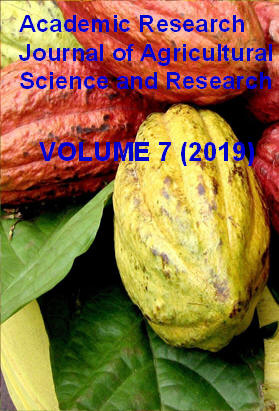|
ISSN: 2360-7874 |
Academic Research Journal of
Agricultural Science and Research |
|||||||||||||||||||
|
Vol. 7(5), pp. 218-226, July 2019 Full Length Research Carbon Sequestration in Agroforestry Practices with relation to other Land Uses around Dallo Mena Districts of Bale Zone, Southeastern Ethiopia
Bikila Mengistu 1, Zebene Asfaw 2
1 Oromia Agricultural Research Institute, Sinana Agricultural Research Center, P.O. Box 208, Bale-Robe, Ethiopia 2 Hawassa University, Wondo Genet College of Forestry and Natural Resources, P.O. Box 128, Shashamane, Ethiopia
Accepted 9 June 2019
Carbon sequestration is the process through which carbon dioxide is absorbed by plants and stored as carbon in biomass and soil. Agroforestry systems have larger chances to sequester Carbon in the long-term, adding aboveground carbon storage capacity through a broader diversity of living forms, including trees and crops (Murthy et al., 2013). The study was conducted in Dallo Mena districts of Bale located in Oromia regional state of Ethiopia. Therefore, this study aims to estimate the amount of carbon stored in agroforestry, and to compare the potential of agroforestry practices with the other common land uses. Based on this study there is significant difference in mean total carbon stock in the three pools among land uses. From all systems the highest total carbon stock were recorded in Natural forest (426.54±95.51 Mg ha-1) followed by shade grown coffee agroforestry (266.61±56.63 Mg ha-1). In the homegarden agroforestry practice, having encompassed different types of plants, there is significant amount of carbon (185.26±20.71 Mg ha-1) stored in the practice. On the other hand, the lower total carbon stocks were observed in the crop field (97.56±6.85 Mg ha-1). From the two agroforestry practices the highest total carbon stock were estimated from the shade grown coffee agroforestry. Generally agroforestry practices provide dual function through its multi-functional role in providing income and ecosystem services. At the same time store and conserve large amounts of carbon on the system.
Key words: Biomass, carbon pools, carbon sequestration, land uses, total carbon stock
How to cite this article (APA Style): Bikila M., Zebene A (2019). Carbon Sequestration in Agroforestry Practices with relation to other Land Uses around Dallo Mena Districts of Bale Zone, Southeastern Ethiopia. Acad. Res. J. Agri. Sci. Res. 7(5): 218-226
|
|||||||||||||||||||
